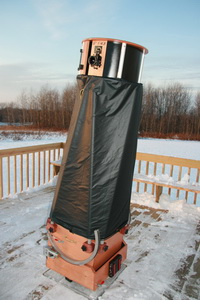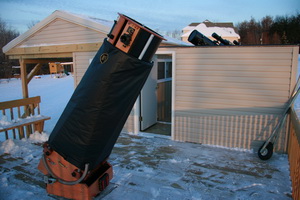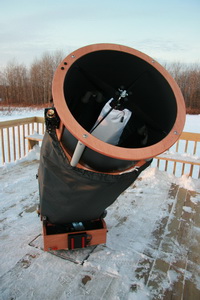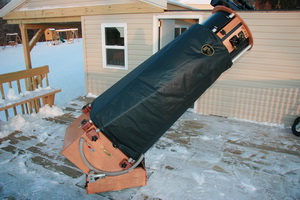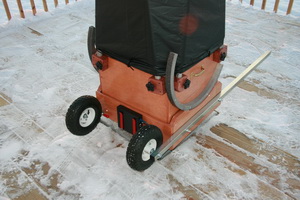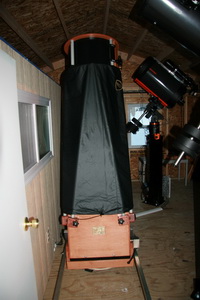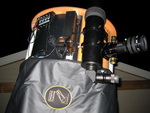Telescopes
Obsession 18" Classic Dobsonian
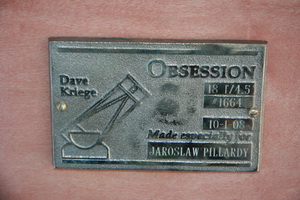 Obsession
18" Classic is my primary visual telescope. Its aperture is large enough
to show breathtaking views, but it is still not too tall, all I need is
a stepladder when looking at zenith. When
planning for my backyard observatory in 2008 I have decided that my CGE1400 will
be permanently mounted on the pier and used mostly for imaging.
Therefore I needed a portable visual scope with a reasonable aperture
for deep sky observing. After a short research I decided for 18"
Obsession,
Dave Kriege of Obsession
Telescopes has an excellent reputation assuring that I will get top
notch scope.
Obsession
18" Classic is my primary visual telescope. Its aperture is large enough
to show breathtaking views, but it is still not too tall, all I need is
a stepladder when looking at zenith. When
planning for my backyard observatory in 2008 I have decided that my CGE1400 will
be permanently mounted on the pier and used mostly for imaging.
Therefore I needed a portable visual scope with a reasonable aperture
for deep sky observing. After a short research I decided for 18"
Obsession,
Dave Kriege of Obsession
Telescopes has an excellent reputation assuring that I will get top
notch scope.
I have ordered my Obsession equipped with Argo Navis digital setting circles, ServoCat GoTo system, nylon shroud, Telrad, 80mm finder, dew heater for the secondary mirror and Dave's original counterweight system. For the mirror I chose OMI optics, and I am not disappointed: it is excellent. The quality and workmanship of Obsession is truly outstanding, they really deserve their reputation. The pictures of the original Obsession setup are at the bottom of the page. Over time I added several accessories and made modifications to improve my observing.
Celestron C80ED as finder scope. Celestron 80mm ED refractor is a nice wide-field telescope, with my old Orion 40mm Optiluxe eyepiece it is an excellent finder scope (4 degrees field of view). It is a bit heavy, so I had to add more counterweights, but it allows the comfort of using two telescopes at the same observing session by just moving head a bit. Comparing views is very useful, and it is interesting to see the same object in so different scales.
RCW/FCW counterweight system from Markless Astronomics. With C80ED, Telrad and a heavy eyepiece on the top of the scope there is no chance to balance it without serious counterweights. Initially I just used Dave's system consisting of 3 aluminum tubes mounted underneath the main mirror. I filled the tubes with sand, but it was too light, and in the end I had to use lead shot. It was still not enough, so I added RCW/FCW system from Markless Astronomics which is easily adjustable: the counterweights can be moved up and down the rail (see picture above). I installed two of them, on the opposite sides of the rocker box.
Markless Astronomics stalk. Argo Navis hand pad and motor control pad for ServoCat are best accessible using a stalk on the side of the telescope. Often I attach ServoCat pad (which is very light) using Velcro to the upper cage, but Argo Navis pad stays on the stalk. I can cover it with a plastic bag on especially damp nights. Nowadays I exclusively use tablet control (see below), so Argo Navis pad stays on the stalk all the time.
Markless Astronomics truss power system. There is a need for a lot power for dew control on the upper cage, running it just with cables is messy, so I ordered a system allowing power transfer via trusses. It works very well and powers my Thousand Oaks Dew Controller delivering power to dew heaters on two eyepieces, Telrad, finder scope, secondary mirror and filter slide.
Short trusses. The original trusses are optimal for the scope size, but do not allow for accessories like binoviewer to come in focus. Therefore I have ordered shorter trusses from Dave, it turned out I am using them all the time, especially that I also use Tele Vue Paracorr so I can slide it a bit out of focuser. With shorter trusses and binoviewer I use 1.6x Barlow lens (SBW-1.6x OCA for binoviewer from Siebert Optics).
Filter slide. Changing 2" filters is time consuming and distracts from observing, to improve on that I bought wooden heated filter slide from Astrocrumb with space for 3 filters and installed it on the inside of the upper cage. It has now Orion SkyGlow Broadband Light Pollution Filter, Orion UltraBlock Narrowband Filter and Orion OIII Line Filter. I am using them frequently, it is very easy to move the slide by just reaching with a hand up.
Eyepieces. I use 6 eyepieces with my Obsession, they are all listed in the table at the bottom of the page along with technical data. The most used eyepieces are TeleVue Ethos 21mm and Celestron Luminos 15mm. I found that 15mm Luminos 137x magnification gives the image scale that is just right for most nights, so the air turbulence is not disturbing the view. It also produces good brightness and contrast, lots of details show on smaller object, especially galaxies. I like TeleVue 21mm very much as well, it is often used for larger objects or on nights with worse seeing conditions. It is also better with the filters. I also use Orion Expanse 20mm with my binoviewer which yields approximately 0.4º (24') field of view with 1.6 Barlow required for focusing. For planets I use Radian 10mm or Lanthanum 7.5mm - seeing in the Northeast is usually not good enough for any higher magnification. In order to compensate for coma inherent in any fast parabolic optics I use TeleVue Paracorr.
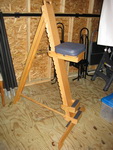 The views from this scope are fantastic! My observatory limiting
magnitude is 6.24 (on best nights) and it helps too, but even when there is
a haze or Moon
in the sky this scope is really the best. Very easy to use: roll it out
to the pad, remove handles, attach stalk, connect cables (and power),
uncover mirror - and I am ready! On a good night M51 looks almost like
on pictures (except for color of course), M101 shows its ghostly arms
with no problem, and major globular clusters resolve the stars to the
core. Dream visual scope, it is
The views from this scope are fantastic! My observatory limiting
magnitude is 6.24 (on best nights) and it helps too, but even when there is
a haze or Moon
in the sky this scope is really the best. Very easy to use: roll it out
to the pad, remove handles, attach stalk, connect cables (and power),
uncover mirror - and I am ready! On a good night M51 looks almost like
on pictures (except for color of course), M101 shows its ghostly arms
with no problem, and major globular clusters resolve the stars to the
core. Dream visual scope, it is
![]() .
I need a small stepladder (with two steps) to reach eyepiece when
pointing close to zenith - I am 6' 1" tall. I can still use a variable height Orion chair
with the 18" Obsession, but the regular chair is too small for most
targets. I bought
CatsPerch
Summit observing chair which is MUCH higher, and it works well,
especially if I
am looking at objects that are close in the sky for an extended period
of time. I use Cats Perch when examining something in more detail
and longer time, most often I just use the regular chair and stepladder.
.
I need a small stepladder (with two steps) to reach eyepiece when
pointing close to zenith - I am 6' 1" tall. I can still use a variable height Orion chair
with the 18" Obsession, but the regular chair is too small for most
targets. I bought
CatsPerch
Summit observing chair which is MUCH higher, and it works well,
especially if I
am looking at objects that are close in the sky for an extended period
of time. I use Cats Perch when examining something in more detail
and longer time, most often I just use the regular chair and stepladder.
Computer and tablet control.
Argo Navis and ServoCat are a very good investment too. Argo Navis is easy to calibrate while ServoCat easily moves the scope to the target and keeps it there. You can disconnect ServoCat motors at any moment and reconnect at will. I usually calibrate Argo Navis manually without motors engaged (it is just faster) and then engage ServoCat motors for pointing and tracking. It does save a lot of time compared to star hopping, especially for fainter objects, instead of looking after the object I can look at the object. And good dark nights are rare here, so I it is a good idea to maximize observing time. Definitively it is one of the best accessories one can buy for an Obsession. The best feature of all is that I can connect Argo Navis and ServoCat to a tablet (or smartphone) and use observing lists with a planetarium program from there.
Using Argo Navis exclusively has a disadvantage: switching between objects and/or choosing an object is cumbersome - one needs to choose with the dial, which is harder than just punch the numbers on Celestron hand pad. The best solution is to connect the system to a planetarium app on a tablet. After long research and lots of experimentation I chose Sky Safari Pro for the software. It has excellent databases for stars and deep sky objects, good support for telescope control and capability of managing extensive set of observing lists. I have developed a multitude of observing lists based on books, articles and experience, they allow me to focus and explore various aspects of astronomy with ease.
To connect the telescope to tablet I connect ServoCat to Orion StarSeek using ServoCat serial cable. StarSeek then connects to ZyXEL Wireless N 3-in-1 Travel Router - a very cheap router (~$20 on Amazon) that can be powered in the field using any USB charger. Before first use router needs to be set up to serve a local WiFi network and StarSeek must be configured to connect to it.
For each observing session I first align the scope with two stars as usual, after that I select "From Planetarium" option on Argo Navis pad. Then I power up ZyXel and connect Star Seek to ServoCat. Next I connect my tablet to the WiFi network and finally I start Sky Safari and connect the scope. My current tablet is iPad Pro 12.9".
I use Sky Safari on my tablet almost exclusively now. It is the easiest way to observe, I can select objects from a list, or I can highlight all the objects from a list on the sky map and select from there, or finally I can browse the sky directly in planetarium mode. Even better, I can always tap selected object info and read about it, including detailed description and physical properties. Here is the page with all my observing lists.
Portability.
My Obsession is travelling with me about once a year to Black Forest Star Party in Cherry Springs, PA. I disassemble it for travel, removing upper cage, trusses etc, but lower part with the mirror needs to get to the car in one piece. I bought foldable aluminum ramps to wheel it to the back of my car without any help. Now when I shop for a new car (last happened in spring 2016) I start with measuring if the scope can fit. The size of the scope now dictates the size of the car!

Below are the pictures of the original configuration from the Fall 2008.




